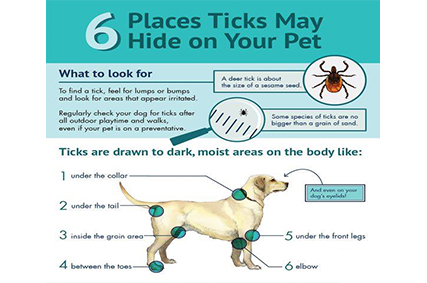Lyme Disease in Dogs
Feb. 23, 2023
Lyme Disease in Dogs
What is Lyme disease?
Lyme disease, which caused by Borrelia burgdorferi, is transmitted to dogs through the bite of an infected tick. Once in the bloodstream, the Lyme disease organism is carried to many parts of the body and is likely to localize in joints or kidneys.

Can Lyme disease also affect people?
Yes, but people do not get it directly from dogs. They get it from being bitten by the same ticks that transmit it to dogs. Therefore, preventing exposure to ticks is important for you and your dog.
What are the clinical signs of Lyme disease in dogs?
Many dogs affected with Lyme disease are taken to a veterinarian because they seem to be experiencing generalized pain and have stopped eating. Affected dogs have been described as if they were walking on eggshells. Often, these pets have high fevers. Dogs may also begin limping. This painful lameness often appears suddenly and may shift from one leg to another and if left untreated, may eventually disappear, only to recur weeks or months later.

Non-specific signs which may indicate that Lyme disease is affecting the kidneys include vomiting, lethargy, anorexia (lack of appetite), and weight loss. The kidney form of the disease is less common but often fatal.
Most dogs infected with the Lyme disease organism take two to five months before they show symptoms. By this time, the disease may be widespread throughout the body.

How is Lyme disease diagnosed?
Dogs with lameness, swollen joints, and fever are suspected of having Lyme disease. However, other diseases may also cause these symptoms. There are a few blood tests that may be used for confirmation.
The first is an antibody test that your veterinarian can perform in the clinic using a special test kit, like W81301 Quicking Lyme Ab Test. It can detect the presence of antibodies created by exposure to the organism, but can be falsely negative if the dog is infected, but has not yet formed antibodies, or if it never forms enough antibodies to cause a positive reaction. It is recommended to test no earlier than four weeks after a tick bite. Some dogs that have been infected for long periods of time may no longer have enough antibodies present to be detected by the test. Therefore, a positive test is meaningful, but a negative is not.

Other tests including PCR (polymerase chain reaction), ELISA (enzyme-linked immunosorbent assay), joint fluid analysis, and culture can also be done with varying degrees of sensitivity but are less often performed. General blood and urine tests are also often done to assess kidney function and look for loss of protein in the urine. See handout “Testing for Lyme Disease in Dogs” for further information.



